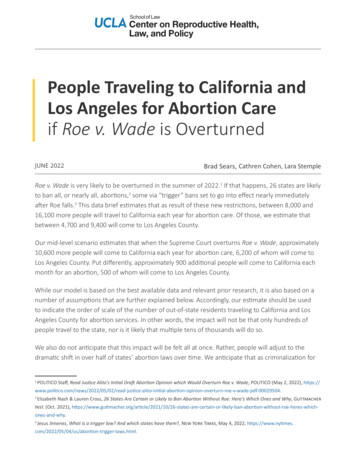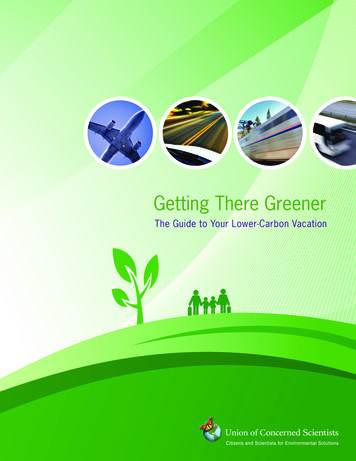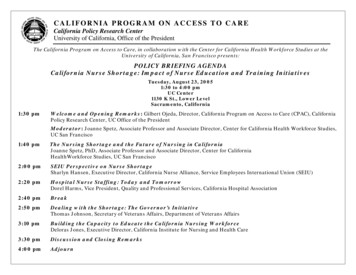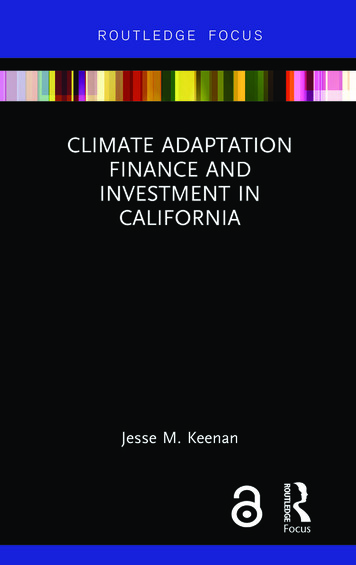
Transcription
Center on Reproductive Health,Law, and PolicyPeople Traveling to California andLos Angeles for Abortion Careif Roe v. Wade is OverturnedJUNE 2022Brad Sears, Cathren Cohen, Lara StempleRoe v. Wade is very likely to be overturned in the summer of 2022.1 If that happens, 26 states are likelyto ban all, or nearly all, abortions,2 some via “trigger” bans set to go into effect nearly immediatelyafter Roe falls.3 This data brief estimates that as result of these new restrictions, between 8,000 and16,100 more people will travel to California each year for abortion care. Of those, we estimate thatbetween 4,700 and 9,400 will come to Los Angeles County.Our mid-level scenario estimates that when the Supreme Court overturns Roe v. Wade, approximately10,600 more people will come to California each year for abortion care, 6,200 of whom will come toLos Angeles County. Put differently, approximately 900 additional people will come to California eachmonth for an abortion, 500 of whom will come to Los Angeles County.While our model is based on the best available data and relevant prior research, it is also based on anumber of assumptions that are further explained below. Accordingly, our estimate should be usedto indicate the order of scale of the number of out-of-state residents traveling to California and LosAngeles County for abortion services. In other words, the impact will not be that only hundreds ofpeople travel to the state, nor is it likely that multiple tens of thousands will do so.We also do not anticipate that this impact will be felt all at once. Rather, people will adjust to thedramatic shift in over half of states’ abortion laws over time. We anticipate that as criminalization for1POLITICO Staff, Read Justice Alito’s Initial Draft Abortion Opinion which Would Overturn Roe v. Wade, POLITICO (May 2, 2022), wade-pdf-00029504.2Elizabeth Nash & Lauren Cross, 26 States Are Certain or Likely to Ban Abortion Without Roe: Here’s Which Ones and Why, GuttmacherInst. (Oct. 2021), heres-whichones-and-why.3Jesus Jimenez, What is a trigger law? And which states have them?, New York Times, May 4, 2022, gger-laws.html.
People Traveling to California and Los Angeles for Abortion Care if Roe v. Wade is Overturned 2abortion care increases and as abortion clinics close in many states, the number of people travelingto California will grow. The large number of abortion restrictions that have been passed by statelegislatures in the past several years also means that it is likely that this level of legislative activitywill continue in restrictive states, as will enforcement efforts once new restrictions are passed. Thiswill include attempts to criminalize people who travel out of state for abortion care, and those thatattempt to assist them.Prior research suggests several characteristics of those who currently travel to obtain abortionservices, some of which may be relevant to predicting the population of people who will travel toCalifornia for abortion care in the future: In terms of demographic and socio-economic characteristics, all types of people will travel toCalifornia for abortion services. Studies have shown that under the current landscape of state laws and availability ofcare, women of color, those without insurance, those who live in states without Medicaidexpansion, and those with fewer resources are currently more likely to have to travel longerdistances.4 Other research suggests that those with greater resources are more likely to travel to obtainabortion care, including white, college-educated people with more economic and socialresources.5 Those aged 17 and younger may be more likely to travel to California for abortion access,particularly from states with parental consent laws.6 Those with longer gestational lengths and/or greater complications are more likely to travelfurther for abortion care.74Jill Barr-Walker et al., Experiences of Women who Travel for Abortion: A Mixed Methods Systematic Review, 14 PLoS ONE (Apr. .5Liza Fuentes & Jenna Jerman, Distance Traveled to Obtain Clinical Abortion Care in the United States and Reasons for Clinic Choice, 28J. Women’s Health 1623 (Dec. 2019); Rachel K. Jones & Jenna Jerman, How Far Did US Women Travel for Abortion Services in 2008?,22 J. of Women’s Health 706 (Aug. 2013), 83 (finding that women of colorwere less likely to travel long distances compared to non-Hispanic white women).6Barr-Walker et al, supra note 4; Fuentes & Jerman, supra note 5. See also Amanda Dennis et al., The Impact of Laws RequiringParental Involvement for Abortion: A Literature Review, Guttmacher Inst. (Mar. 2009), ew (“the clearest documented impact of parental involvement laws isan increase in the number of minors traveling outside their home states to obtain abortion services in states that do not mandateparental involvement or that have less restrictive laws;” two studies of parental involvement laws in Mississippi and Texas found nodecline in minor’s abortion rate once out-of-state abortions were considered.).7Fuentes & Jerman, supra note 5; Barr-Walker et al., supra note 4; (“Gestational age played a role as both an exposure and outcomerelated to travel in the reviewed studies: women at higher gestational ages often traveled farther distances to access abortion, andwomen whose limited access to abortion necessitated farther travel distances experienced delays that resulted in higher gestationalages or prevented them from obtaining an abortion altogether”); Rachel K. Jones & Jenna Jerman, How Far Did US Women Travelfor Abortion Services in 2008?, 22 J. of Women’s Health 706 (Aug. 2013), 83
People Traveling to California and Los Angeles for Abortion Care if Roe v. Wade is Overturned 3 Those who are seeking specialized or higher quality care or who have concerns about privacy,legal concerns, and safety will be more likely to travel.8 This suggests that the efforts byCalifornia and Los Angeles to serve as safe havens for reproductive freedom will cause some totravel to this area instead of to closer locations.M E T H O D O LO GYWe base our estimates on the following:If Roe v. Wade is overturned, the Guttmacher Institute has estimated that in the short-term, 26 statesare likely to ban all, or nearly all, abortions.9 (See Table III).We use estimates from a 2022 study published in The Lancet Regional Health – Americas for thenumber of abortions among state residents in each of these twenty-six states.10 Using the same study,we subtract those who are already leaving their states for abortion care.11 (See Tables I and II). TheLancet study found that in 2017 “an average of 8% of patients left their state of residence for abortioncare.”12 We assume that people who are already leaving their states for California are reflected in thecurrent number of abortions being performed in California (i.e., they will not be part of an increase inpeople coming to California for abortion services if Roe is overturned).Those in the 26 states with new abortion restrictions will respond in several ways, including byincreasing the use of contraception,13 carrying pregnancies to term,14 engaging in self-managed(finding that women of who obtained a second semester abortion were more likely to travel greater distances); Ushma D. Upadhyay etal., Denial of Abortion Because of Provider Gestational Age Limits in the United States, 104 J. of Pub. Health 1687 (Sept. 2014), /AJPH.2013.301378 (finding that needing to raise money for travel is often a reason forseeking an abortion in the second trimester).8Barr-Walker et al., supra note 4.9Nash & Cross, supra note 2.10Mikaela H. Smith et al., Abortion Travel Within the United States: An Observational Study of Cross-State Movement to ObtainAbortion Care in 2017, 10 The Lancet Regional Health – Americas (Mar. 2022), S2667193X2200031X?via%3Dihub#.11Id.12Id. The percent leaving varied widely by state. For example, 74% left Wyoming, 57% left South Carolina, and 56% left Missouri, whilethirteen states had fewer than 4% of patients leaving.13Josephine Jacobs & Maria Stanfors, State Abortion Context and U.S. Women’s Contraceptive Choices, 1995-2010, 47 Perspectiveson Sexual and Repro Health 71 (June 2015), https://www.jstor.org/stable/48576720 (finding that women who live in states whereabortion access was low or in states characterized by abortion hostility were more likely than women living in a state with greateraccess or states with less hostility to use highly effective contraceptives rather than no method).14Elizabeth A. Pleasants, Alice F. Cartwright, & Ushma D. Upadhyay, Association Between Distance to an Abortion Facility and Abortionor Pregnancy Outcome Among a Prospective Cohort of People Seeking Abortion Online, 5; JAMA Network Open (2022), ullarticle/2792291; Joanna Venator & Jason Fletcher, Undue Burden Beyond Texas:An Analysis of Abortion Clinic Closures, Births, and Abortions in Wisconsin, 40 J. of Pol’y Analysis & Management 774 (Nov. 2020),
People Traveling to California and Los Angeles for Abortion Care if Roe v. Wade is Overturned 4abortion,15 seeking medication abortion in increasing proportions, and traveling out-of-state forabortion care.16 For example, when Texas made abortion care after 16 weeks gestation more difficultto obtain, “the effect was immediate and dramatic. The number of abortions performed in Texas ator after 16 weeks gestation dropped 88%, from 3,642 in 2003 to 446 in 2004, while the number ofresidents who left the state for a late abortion almost quadrupled.”17 In our model, we use a low,middle, and high scenario, assuming that 25%, 33%, or 50% of those who would have had an abortionin their home state will travel out of state if Roe is overturned. (See Tables IV and V).Prior research suggests that travel distance is a primary determinant in where people go to have anabortion.18 A study published in 2019 found that, “the provider being the closest was a main reasonabortion patients chose their facility and that nearly half of all abortion patients traveled to theirnearest provider, indicating that distance is an important determinant of abortion access.”19Prior research also suggests that people, when forced to do so, will travel longer distances to getthe care they need20 and that when states restrict abortion, people travel greater distances to seekabortion care, including out of state.21 For example, a 2019 systematic review of the literature onwomen’s experiences traveling for abortion 22 considered 59 studies and found that “legal restrictionsand the limited availability of abortion providers “resulted in women needing to travel long distancesfor abortion services, often crossing state or country borders to seek care . . . [s]tudies describe thesubstantial distances that women often need to travel in order to obtain abortion services; in thesehttps://doi.org/10.1002/pam.22263 (estimate the impacts of abortion clinic closures in Wisconsin and finding that a 100-mile increasein distance to the nearest clinic is associated with 30.7 percent fewer abortions and 3.2 percent more births); but see Dennis et al.,supra note 6 (many studies of the impact of parental involvement laws find that a decline in minor’s abortion rate, but most did notmeasure out-of-state abortions; two that did found no impact on the abortion rate; further, several studies found no short-term impacton pregnancy rates).15Lauren Ralph et al., Prevalence of Self-Managed Abortion Among Women of Reproductive Age in the United States, 3 JAMA NetworkOpen (Dec. 2020), ullarticle/2774320 (finding that as abortion becomes morerestriction, self-managed abortion may become more common).16Dennis et al., supra note 6 (“the clearest documented impact of parental involvement laws is an increase in the number of minorstraveling outside their home states to obtain abortion services in states that do not mandate parental involvement or that have lessrestrictive laws.”).17Silvie Colman & Ted Joyce, Regulating Abortion: Impact on Patients and Providers in Texas, 30 J. of Pol’y Analysis & Mgmt 775 (July2011), 603.18Fuentes & Jerman, supra note 5 (“travel distance is an important determinant of abortion care access in the United States”).19Id. (“travel distance is an important determinant of abortion care access in the United States”).20See e.g., Caitlin Gerdts, et al., Impact of Clinic Closures on Women Obtaining Abortion Services After Implementation of a RestrictiveLaw in Texas, 106 Am. J. of Pub Health 857 (May 2016), /AJPH.2016.303134.21Barr-Walker et al., supra note 4 (“When stated, almost all reasons were framed in the contexts of increased legal restrictions thatlimited women’s access to clinics or where residence in regions in which legal barriers to care necessitated travel, including presentingbeyond gestational age limits for termination.”).22Id.
People Traveling to California and Los Angeles for Abortion Care if Roe v. Wade is Overturned 5studies, many participants traveled over 50, 100, or even 200 miles to reach an abortion provider.”23In terms of out-of-state travel, one study found that 6.4% of people were already traveling out ofstate to obtain abortion care in 2014, before hundreds of recent abortion restrictions had beenenacted, and that 17% of those seeking abortion (estimated to be 155,000 people) traveled 50 milesor more for abortion care.24 Moreover, it found that for those who live outside of urban areas (innon-MSA regions), 36% of patients traveled more than 100 miles for abortion services.25 It also foundthat “among abortion patients aged 17 and younger, 11% of those in a parental involvement statestraveled more than 100 miles compared with 2% in states with no such law.”26 The Lancet studydescribed above found that “states with more restrictive laws averaged 12% of patients leaving thestate for abortion care while states with middle ground or supportive laws averaged 10% and 3%leaving, respectively.”27A more recent study28 analyzed the impact of Texas Senate Bill 8 (SB 8), which bans abortion upondetection of embryonic cardiac activity, which can take place as early as five to six weeks after aperson’s last menstrual period and before many people know that they are pregnant. 29 The studyfound that “[m]any pregnant Texans have been traveling to neighboring states to obtain abortioncare, and some have traveled as far as Illinois, Maryland, and Washington.”30 More specifically, in justlooking at 34 of the 44 open abortion facilities in seven nearby states (Arkansas, Colorado, Kansas,Louisiana, Mississippi, New Mexico, and Oklahoma), the study found that the number abortions forTexas residents jumped from 235 a month to an average of 1,391 a month. In other words, an increaseof over 1,156 per month.31Research also suggests that those who do travel out of state for abortion care are more likely totravel to a neighboring state, when compared to nearby, but not neighboring, states. The study onthe impact of Texas’s SB 8 found that, among seven nearby states, 75% of Texans traveled to just twostates: Oklahoma (45%) and New Mexico (27%).32 (Notably, Oklahoma recently enacted an abortion23Id.24Fuentes & Jerman, supra note 5. Id.25Id.26Id.27Smith et al., supra note 10.28Kari White et al., Out-of-State Travel for Abortion Following Implementation of Texas Senate Bill 8, Texas Pol’y Eval. Project (Mar.2022), -out-of-state-SB8.pdf.29Id.30Id.31Id. These data undercount the total number of Texans receiving care out of state since it did not obtain data from ten facilities inthese states, and it does not include Texans who have traveled to other states.32Id.
People Traveling to California and Los Angeles for Abortion Care if Roe v. Wade is Overturned 6ban that is now the strictest in the nation,33 which means Texans and people from other states nolonger have an incentive to travel there.) Similarly, an earlier study that looked at the impact of Texaslimiting abortions performed after 16 weeks gestation and that tracked Texans traveling to nineneighboring states, found that 99% of people traveled to the five closest of those nine states.34It is also important to keep in mind that “travel” isn’t simply measured by looking at a map orthe straight distance between states, counties, or abortion clinics. People will travel by car, publictransportation, and airplanes to seek abortion.35 Transportation routes, travel time, and a fullconsideration of transportation and other costs need to be accounted for when considering theburden of travel. 36 For these reasons, the World Health Organization recommends using travel time,rather than travel distance, as a measure of accessibility for health care access.37Los Angeles serves as a major hub for airlines, hosts several airports, and is home to LAX, the fifthlargest airport in the U.S. With frequent flights and a number of discount airlines serving the area,we anticipate that Los Angeles will be easier to reach than many smaller cities. For example, a flightfrom Dallas to Los Angeles may take less time than driving to a closer state or clinic, which may beimportant for those with work and/or childcare responsibilities and who wish to tell fewer peopleabout the trip or the purpose of the trip.38However, because flying is usually more expensive than driving, the proportion of people who willchoose these options may depend on the extent to which abortion funds or others are helping to paythe cost of the flight and lodging. To the extent that such funds are available and are widely known,and for those who can afford it without such help, the best choice for a person in Texas might be to flyto Los Angeles as opposed to driving or taking a bus or train to a clinic in a closer state.However, proximity, ease of travel, and cost are not the only things people consider when deciding33Associated Press, Oklahoma governor signs the nation's strictest abortion ban, NPR (May 26, 2022), tion-ban.34Colman & Joyce, supra note 17 (“Almost all women who left Texas for a late termination in 2004 went to a neighboring state. Ofthe 736 abortions by Texas residents recorded by state health departments in nine nearby states, 726 (99 percent) occurred in thefive neighboring states (Arkansas, Kansas, Louisiana, Oklahoma, and New Mexico). The remaining ten abortions (1 percent) obtainedout of state occurred in Colorado (9) and Missouri (1). Data collected from Mississippi and Tennessee indicated that there were noabortions after 15 weeks' gestation by Texas residents in those states from 2004 to 2006. Given the very small number of women whotraveled beyond the five neighboring states for a late abortion, we are confident that our results are not affected by the lack of data onabortions to residents of Texas obtained from other states.”).35Barr-Walker et al., supra note 4 (“Almost all studies in this review contained descriptions of the modes of transportation women usedwhen traveling for abortion services. Participants described traveling for abortion via airplane, private car, and public transportation.”).36Id.37World Health Org., Background Paper for the Technical Consultation on Effective Coverage of Health Systems (2001).38Barr-Walker et al., supra note 4 (“Other burdens related to travel, such as time away from work and the inability to keep one’sabortion confidential, were reported more often in qualitative studies.”).
People Traveling to California and Los Angeles for Abortion Care if Roe v. Wade is Overturned 7between abortion clinics. One study found that most people will consider multiple clinics and takeinto account the reputation of the clinic, wait times, online reviews, references from people theyknow, privacy concerns, legal concerns, and safety.39 This indicates that people may be willing to travelfurther to clinics in California and Los Angeles, and that those preferences will be shaped by the extentto which the state and county are affirmatively creating safe havens for abortion care. For example,when Poland recently prohibited abortion, affirmative outreach and support efforts by organizationsand countries in the Europe Union led to the assistance of over 1,000 people who traveled to clinicsoutside of Poland.40Accordingly, we use geographic proximity as well as the additional factors described above to createdifferent assumptions for different sets of states about what percentage people will travel to Californiato have an abortion (See Table IV): Arizona – We assume 50% of those who travel out of state for abortion care from Arizonawill travel to California. Arizona shares a long border with California. More people fromArizona than from any other state visit California for tourism each year, indicating that thistravel pattern and its infrastructure are well established.41 We also note that Arizona bordersMexico,42 although it is unclear how many people will travel outside of the country to get anabortion. Utah and Texas – We assume 25% of those who travel out of state for abortion servicesfrom Utah and Texas will travel to California. Utah and Texas are close to California and manypeople from these states also visit California for tourism each year, indicating that thesetravel patterns and their infrastructure are well established.43 We also note that Texas borders39Orlaith Heymann et al., Selecting an Abortion Clinic: The Role of Social Myths and Risk Perception in Seeking Abortion Care, 63 JHealth Soc. Behav. 90 (2021), https://pubmed.ncbi.nlm.nih.gov/34605701/. In another study, women reported traveling to the UnitedStates for abortion care because of perceived lack of safety of the procedure in Mexico (their country of residence). See Barr-Walker etal., supra note 4.40Women Help Women, Abortion Without Borders Helps More Than 34,000 People in Poland Access Abortions (Oct. 21, 2021), 41Visit California, California Travel-Related Spend & Visitation Forecast (May Update) (May 17, 2022), el-forecast (slide 33 of the PowerPoint). More people traveled to California in 2019 for domestic leisure trips fromArizona (12.3 million trips) and Texas (9.9 million trips) than any other states).42While Mexico’s Supreme Court rule that some restrictions on abortion in the county could be unconstitutional, the extent of thatdecision’s impact will be worked out by state legislatures and future court decisions. At this point, it is not clear to what extentabortion will be more available in Mexico than in states in U.S. that border Mexico and that will ban abortion. See Natalie Kitroeff &Oscar Lopez, Abortion is No Longer a Crime in Mexico. But Most Women Still Can’t Get One, N.Y. Times (Sept. 8, 2021), mexico-abortion-access.html. An earlier analysis questioned the extent to which peoplewould travel outside of the country to obtain abortions and suggests that, at least in Texas, abortions in counties that border Mexicoare a small fraction of all abortions in border states. See Colman & Joyce, supra note 17.43Visit California, supra note 41 (slide 33 of the PowerPoint). More people traveled to California in 2019 for domestic leisure tripsfrom Arizona (12.3 million trips) and Texas (9.9 million trips) than any other states. Among states that are likely to ban abortion if Roev. Wade is overruled, Utah had the largest number of domestic leisure trips (3.4 million trips). Among all states, Utah ranks eighth in
People Traveling to California and Los Angeles for Abortion Care if Roe v. Wade is Overturned 8Mexico,44 although, again, it is unclear how many people will travel outside of the country toget an abortion. While other states near Utah (Nevada, Colorado, and New Mexico) and Texas(New Mexico, Colorado, and Kansas) are likely to continue to allow abortion in the short term,the limited number of clinics in these states might push residents to travel farther to California.The study of the impact of Texas’ SB 8, described above, found that wait times at clinics inneighboring states, including New Mexico and Kansas, increased after the passage of SB 8:about half of the facilities “had wait times of two weeks or more, which may push pregnantpeople past the limit for medication abortion or into the second trimester of pregnancy.”45More specifically, Kansas has only four abortion clinics, and half the abortions currentlyperformed there are already for out-of-state residents.46 New Mexico has only six abortionclinics and wait times already extend to up to three weeks.47 Other states in nearby census regions and divisions – We next consider additional states innearby U.S. Census Bureau Divisions48 that will ban abortion if Roe v. Wade is overturned. In theWest: Mountain Division, Idaho, Montana, and Wyoming will ban abortion. In the South: WestSouth-Central Division, Arkansas, Louisiana and Oklahoma will ban abortion. We note that thesestates have between one and four other nearby states closer than California, where abortionwill remain legal (Nevada, Washington, Oregon, Colorado, New Mexico, Kansas). In addition,residents from some of the Mountain Division states might go to Canada for abortions.49However, the limited number of clinics in these states, such as Kansas and New Mexico, mightpush residents to travel farther to California.50 For these states we assume 10% of those whotravel out of state for abortion care will travel to California. Since no states in the West: PacificDivision are poised to ban abortion in the short-term (Alaska, Hawaii, Oregon, and Washington),we do not assume any increase in those traveling to California from these states. Remaining states that will ban abortion – For all other states that will ban abortion, fallingin the Eastern half of the United States, we assume that only 5% of those who travel out ofstate for abortion care will travel to California. Residents of these states will have a numberof options on the East Coast, as well as other parts of the United States, Mexico, and Canada.terms of domestic leisure trips to California (by comparison New York accounts for 4.8 million trips).44See Colman & Joyce, supra note 17.45White et al., supra note 28.46Guttmacher Inst., State Facts About Abortion: Kansas (May 2022), tsheet/sfaa-ks.pdf; Josh Merchant, Nearly Half of Abortions in Kansas are for Missouri Residents, but Voters Could End That, KCUR (Nov. 20, ents-but-voters-could-end-that.47White et al., supra note 28.48U.S. Census Bureau, Census Regions and Divisions of the United States, ference/us regdiv.pdf (last visited June 3, 2022).49Andy Blatchford, Canada is Open to Americans Who May Lose Access to Abortions, but There’s a Catch, POLITICO (May 5, er Inst, supra note 46; Merchant, supra note 46.
People Traveling to California and Los Angeles for Abortion Care if Roe v. Wade is Overturned 9However, we assume that because 12% of the United States population lives in California,51some will travel to California because they have friends, family, and other forms of support inthe state. Further, a number of closer states have more limited capacity to handle out-of-stateresidents. Finally, California and Los Angeles are already among the country’s top domestictravel destinations, again indicating established travel patterns and infrastructure.52 Remaining states that will not ban abortion – We do not assume any increase in peopletraveling to California from other states that will continue to permit abortion over the numberwho are already traveling to California.To estimate the number of people who will travel to Los Angeles County more specifically (See TableV), we use geographic proximity and the additional factors described above. For example, Arizonais closer to Los Angeles than other parts of the state, so we assume most (67%) of those travelingto California for abortion from Arizona will come to Los Angeles County (we assume that others,for example, will go to clinics closer to the border, or near San Diego, Palm Springs, Riverside, etc.).Likewise, we assume that most people traveling from Idaho, Montana, and Wyoming (75%) will nottravel to Los Angeles and will most likely travel to Northern California.L I M I TAT I O N SBecause this publication represents an attempt to predict the future behavior of a group of diversepeople across a large and populous country, it necessarily includes uncertainty. We note the followinglimitations to our analysis. First, we are facing a dramatic and unprecedented change in the legalityof abortion in the United States. Some changes will happen right away, and others will happen overtime. People who ar
Center on Reproductive Health, Law, and Policy Roe v. Wade is very likely to be overturned in the summer of 2022.1 If that happens, 26 states are likely to ban all, or nearly all, abortions,2 some via "trigger" bans set to go into effect nearly immediately after Roe falls.3 This data brief estimates that as result of these new restrictions, between 8,000 and











